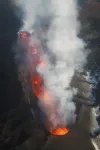INFORMATION:
Further information
Increased respiratory morbidity associated with exposure to a mature volcanic plume from a large Icelandic fissure eruption is published 10:00 GMT 12 April 2021 in Nature Communications. DOI: 10.1038/s41467-021-22432-5.
Exposure to the mature plume was associated with an increase in health care utilisation for respiratory disease by 23% (95%CI 19.7-27.4%) and for asthma medication dispensing by 19.3% (95%CI 9.6-29.1%) during the Holuhraun eruption in 2014.
Research paper affiliations include: University of Leeds; University of Iceland; Icelandic Meteorological Office; Environment Agency of Iceland; Icelandic Directorate of Health; University of Gothenburg; University of Cambridge; Harvard University; National University Hospital, Iceland; Karolinska Institutet, Sweden.
For further details, contact the University of Leeds press office via pressoffice@leeds.ac.uk.
Volcanic pollution return linked to jump in respiratory disease cases
2021-04-12
(Press-News.org) Respiratory disease increased markedly following one of Iceland's largest volcanic eruptions, a new study has found.
And the findings could have significant implications for actions taken to protect the health of the 800 million people globally living near active volcanoes. Indeed, only last month (March), lava burst through a crack in Iceland's Mount Fagradalsfjall in the first eruption of its type in more than 800 years.
The new research, led by the University of Leeds and the University of Iceland, examined the health impacts of pollution caused by the Holuhraun lava eruption in 2014-2015.
It shows that following exposure to emissions that changed chemically from gas to fine particles, incidents of respiratory disease in Iceland rose by almost a quarter, and the incidence of asthma medication dispensing by a fifth.
The findings, published today (10:00 GMT 12 April) in Nature Communications, highlight the need for decision-making authorities to prepare for health issues associated with returning emissions - known as mature plumes - in the days immediately following volcanic eruptions.
The report's co-lead author is Dr Evgenia Ilyinskaya, from the University of Leeds' School of Earth and Environment.
She said: "Volcanoes are a significant source of air pollution, but of course it's a source that cannot be controlled.
"Large volcanic eruptions can cause harmful air pollution both immediately, and also when the plume returns to the same area, which may happen without it triggering air pollution alerts.
"Our research shows that during prolonged eruptions such as Holuhraun, both young and mature plumes can be circulating at the same time, increasing the harmful health effects on those living in volcanic regions.
"This pollution return is not currently factored into responses to the threat to public health caused by volcanoes."
The Holuhraun eruption was one of the biggest of its kind in the last 200 years, releasing 11 million tonnes of sulphur dioxide that spread across Iceland and the Atlantic Ocean towards Europe.
During the six-months long eruption, residents of Iceland's capital, Reykjavík, were repeatedly exposed to the young and mature plumes, despite living 250km from the eruption site.
In their previous research, published in 2017, the scientists traced the evolution of the volcanic plume chemistry. They found that the plume had been swept by air currents towards the UK and mainland Europe before circling back to Icelandic cities and towns.
During this process, the plume composition matured as it lingered in the atmosphere - meaning that the volcanic sulphur dioxide had converted to particles.
These fine particles found in mature plumes are so small they can penetrate deep into the lungs, potentially causing serious health problems such as exacerbating asthma attacks.
In the returning plume, because the sulphur dioxide levels were reduced as the gas converted to particles, concentrations were therefore within European Commission air standards.
As a result, no health advisory message were in place in Iceland for the returning plume.
It is estimated that short and long-term exposure to these kind of fine particles, from both human-made and natural sources, cause over three million premature deaths globally per year and remains the single largest environmental health risk in Europe.
The new findings highlight the health risks of pollutants lingering in the atmosphere, and the implications for monitoring emissions from volcanic activity.
They point to the global need for health risk assessments and population safety management following volcanic eruptions.
Co-lead author Dr Hanne Krage Carlsen, from the University of Iceland and University of Gothenburg, said: "Iceland has some of the most complete health care records in the world. This was the first time a population of a considerable size and density could be assessed following major volcanic activity.
"This study provides the most robust evidence to date that exposure to a chemically-mature volcanic plume leads to increased use of a country's health care system.
"It also emphasizes that emissions from volcanoes are a region-wide issue, in this case potentially affecting the whole North Atlantic region.
"As the Holuhraun plume returned to Iceland, there was increased use of GPs and hospital emergency care units with regards to respiratory diseases. At the same time, there was a lack of public health advice.
"We recommend that future Government responses to volcanic air pollution globally considers both the implications to health caused by the initial eruptions, but also those of the returning plumes with additional threats to health."
ELSE PRESS RELEASES FROM THIS DATE:
Researchers discover new way to starve brain tumours
2021-04-12
Scientists from Queen Mary University of London, funded by the charity Brain Tumour Research, have found a new way to starve cancerous brain tumour cells of energy in order to prevent further growth.
The pre-clinical research in human tissue samples, human cell lines and mice could lead to changes in the way that some children with medulloblastoma are treated in the future, if the findings are confirmed in human clinical trials.
Medulloblastoma is the most common high-grade brain tumour in children. Some 70 are diagnosed in the UK each year. Survival rate is 70 per cent for those whose tumour has not spread but it is almost always fatal in cases of recurrent ...
New research on good cholesterol possibly finds better marker for cardiovascular disease
2021-04-12
Good cholesterol, which is transported in HDLs (high-density lipoproteins), plays a key part in the prevention of atherosclerosis and thus the risk of cardiovascular disease. However, according to a new paper co-authored by researchers at Karolinska Institutet in Sweden and published in the journal Circulation, the anti-inflammatory properties of HDLs could be an even better biomarker for future cardiovascular events.
Atherosclerosis is considered a chronic local inflammation that leads to plaques in the blood vessels and that, if left untreated, can cause cardiovascular ...
New study: Thick sea-ice warms Greenland fjords
2021-04-12
A new study shows that thick sea-ice can increase the sensitivity of Greenlandic fjords to climate warming. Understanding the factors that control how fast glaciers move, break up and deposit chunks of ice (icebergs) into the fjords - and eventually the sea - is vital for predicting how the Greenland ice sheet will change under a warming climate and for predicting global rates of sea-level rise.
A new study led by Stockholm University Assistant Professor Christian Stranne, shows that thick sea-ice outside the fjords can actually increase the sensitivity of Greenlandic fjords to warming. Stranne and a team of researchers from Sweden, Greenland, the Netherlands, the USA, and Canada report on expeditions to two distinct fjords in ...
CPR training offered to just over half of surveyed ON high school students despite mandated training
2021-04-12
Just over half of surveyed Ontario high schools reported providing CPR and AED training to students despite being mandated by the province to provide training for the lifesaving technique, according to a new study by Unity Health Toronto researchers.
The study, published Monday April 12, in CJC Open, surveyed elementary and high schools from 15 different school boards across Ontario to understand the scope of Cardiopulmonary Resuscitation (CPR) and Automated External Defibrillator (AED) training, which are mandated in the Ontario Grade 9 Health and Physical Education Curriculum. Researchers from St. Michael's Hospital of ...
CNIO scientists discovers a combination therapy for aggressive brain tumors
2021-04-12
Glioblastomas are the most common and most aggressive brain tumours. Their survival rate has barely increased over the last 50 years, indicating an urgent need to develop new therapeutic strategies. In a paper published this week in the journal Molecular Cancer Therapeutics, a journal of the American Association for Cancer Research, the team led by Massimo Squatrito, Head of the Seve Ballesteros Foundation Brain Tumour Group at the Spanish National Cancer Research Centre (CNIO), proposes a novel therapeutic strategy based on the combination of temozolomide, the first-line treatment for these patients, and dianhydrogalactitol, a drug that is being tested in clinical trials and is already approved for the treatment of other ...
Those who view TV and social media as trustworthy sources of COVID news -- less informed
2021-04-12
People who trust television and Facebook to provide them with accurate news about the coronavirus pandemic are less knowledgeable about COVID-19, according to a new study, which assessed people's knowledge of the virus in the earliest stages of the pandemic.
The study, published today in the peer-reviewed journal END ...
Study finds rapid evolution in foxgloves pollinated by hummingbirds
2021-04-12
Researchers have found common foxgloves brought to the Americas have rapidly evolved to change flower length in the presence of a new pollinator group, hummingbirds. The findings are published in the British Ecological Society's Journal of Ecology.
Researchers from the University of Sussex, Universidad de Los Andes (Colombia) and Universidad de Costa Rica, studying the common foxglove Digitalis purpurea, a bumblebee pollinated species native to Europe, have shown for the first time how rapid physical changes can occur in flowers following a change in environment and the presence of a new pollinator.
The researchers compared foxgloves in the UK, which ...
Study shows tanning bed ban would reduce skin cancer rates in minors and cut healthcare costs
2021-04-12
A recent study indicates that a U.S. ban on the use of tanning beds among minors would prevent thousands of cases of melanoma in adolescents and would save millions of dollars in healthcare costs. The findings are published early online in END ...
Workplace study during pandemic finds managers should talk less, listen more
2021-04-12
Workplace communication often took a back seat this past year, as employees and employers rushed to work remotely, struggled with technology barriers and adjusted to physical distancing. But the pandemic has resulted in valuable lessons for communicating on the job, according to a Baylor University study.
During the onset of COVID-19 -- along with accompanying layoffs and a recession -- "there likely has never been a moment with such demand for ethical listening to employees," said lead author Marlene S. Neill, Ph.D., associate professor of journalism, public relations and new media at Baylor.
"Ethical listening" was defined by one communication ...
Shift in diet allowed gray wolves to survive ice-age extinction
2021-04-12
April12, 2021 - Gray wolves are among the largest predators to have survived the extinction at the end of the last ice age around11,700 years ago. Today, they can be found roaming Yukon's boreal forest and tundra, with caribou and moose as their main sources of food.
A new study led by the Canadian Museum of Nature shows that wolves may have survived by adapting their diet over thousands of years---from a primary reliance on horses during the Pleistocene, to caribou and moose today. The results are published in the journal Palaeogeography, Palaeoclimatology, Palaeoecology.
The research team, led by museum palaeontologist Dr. Danielle Fraser and student Zoe Landry, analysed evidence preserved in ...




